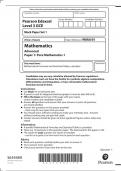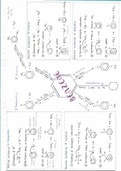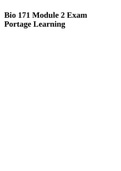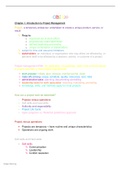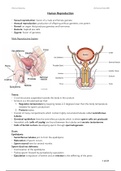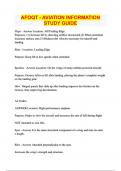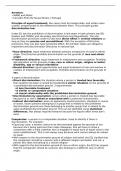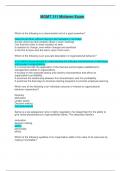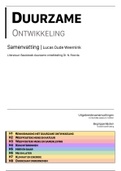Information management summary incl lecture notes
Dear,
Thank you for buying my summary for IM. This summary contains all required book chapters and
lecture slides (except for the last two lectures, as they have not yet taken place at the moment of
making this summary). Only two lectures are just written in their notes as this was additional
information not related to book content. Let me know if I miss something or if you have any tips for
improvements.
Goodluck, studying.
Best, Lynouk
Lecture 1
Ecommerce is the impact of IT on business. It is in two domains:
➢ IT enabled business: A business uses IT to reach customers, produce products and services,
purchase materials, hire personnel etc.
➢ IT provider business: An increasing variety of IT-firms that provide all kinds of products and
services to IT-enabled business.
➢ However, there are many firms within these
domains.
What is information technology? (not in the book)
The big five technologies = SMACIT
➢ Social media: Technologies that enable
communication and creation of virtual
groups.
➢ Mobile computing: Technologies that enable
powerful computing everywhere
➢ Analytics (or big data): Technologies that
enable data analytics and artificial
intelligence
➢ Cloud computing: Technologies that enable
data storage and computing in the cloud.
➢ Internet of things: Technologies that enable
to monitor with smart sensors everywhere.
Web 2.0 technology: A key enabler of e-commerce since 2000.
➢ It allows users to create and share content, preferences, bookmarks, and online personas. It
also enables users to participate in virtual lives and develop online communities.
➢ It allows firms to build and provide online communities (e.g. Twitter) and develop business
models.
➢ Before 2000, Web 1.0 offered only the providers to publish content to users, not vice versa).
Basically web 2.0 technology enables social media technology.
1
,What is data? (not in the book)
Four disruptive aspects of data and IT for E-commerce: not in the book
1. We can compute from data
2. We can deal with messy data
3. We can find hidden correlations in data
4. We can make data visible
Information management: Balancing the needs and services.
Business model: A set of planned activities (processes, operating model) and designed to result in a
profit in a marketplace (value, value proposition).
Core tools in IM: This all need to be used to create a business model
➢ Value modelling: To determine which value is provided by which firm to which client
➢ Process modelling: To determine which processes are designed and executed to provide
value (products and services).
➢ Information modelling: To determine which data are created, used, and exchanged to run
the process and to provide the value.
What is E-commerce? Not in the book
E-commerce: The application of IT to do business. It is
the result of (1) competition and business changes and
(2) new enabling IT. This leads to the reshaping the
business environment.
E-business: The impact of IT at the firm level. Each firm
consist of five operation and four supportive processes (Porter). IT affects:
2
, ➢ All nine business processes + all linkages between these processes
➢ All contracting between firms
➢ Enabling the value chains (firms) to connect into a dynamic (e-commerce) value system.
Thus IT affects all the five forces of porter (see model of five forces of competition), thereby
influencing things such as industry structure, intermediation etc.
Complicated role of IT as business enabler
➢ Information symmetry: IT may trigger transparency (of prices)
➢ Information asymmetry: IT may trigger information overload
Academic disciplines concerned with E-commerce:
➢ Technical approach: Computer science, management science, information systems.
➢ Behavioural approach: Information systems, economics, marketing, management,
finance/accounting, sociology.
Chapter 1 The revolution is just beginning
1.1 the first thirty seconds: why you should study E-commerce
In order to be able to perceive and understand the opportunities and risks that lie ahead, it is
important to study e-commerce. With e-commerce you will be able to:
➢ Identify the technological, business, and forces that have shaped
➢ Continue to shape
➢ The growth of e-commerce
➢ Ready to participate
➢ Guide discussions of e-commerce, analyse and identify models.
1.2 Introduction to E-commerce
E-commerce: The use of the internet, WWW, and mobile apps and browsers running on mobile
devices to transact business. Digitally enabled commercial transactions between and among
organisations and individuals.
➢ Internet: Worldwide network of computer networks
➢ Web: One of the Internet’s most popular services, providing access to webpages
➢ App (application): Software application, often used referring to mobile applications,
sometimes desktop.
➢ Mobile browser: Version of web browser software accessed via a mobile device.
➢ Digital enabled transactions: All transactions mediated by digital technology (Internet, web
and mobile devices)
3
, ➢ Commercial transactions: Transactions that involve exchange of value (e.g. money) across
organisational or individual boundaries in return
for products and services.
Without exchange, no commerce can occur. E-commerce
and digital commerce are in this book synonymous.
E-business: The digital enabling of transactions and
processes within a firm, involving information systems
under the control of the firm. This does NOT equal E-
commerce! E-business applications turn into E-commerce
when an exchange of value occurs. See image.
You can measure the size of the internet by looking at the
number of Internet hosts with domain names.
➢ Internet host: Defined by the Internet Systems
Consortium as any IP address that returns a domain
name in the in-addr.arpa domain, which is a special
part of the DNS namespace the resolves IP
addresses into domain names.
➢ WWW: An information system that runs on the
intenret infrasturuce. Originally a killer app that
made the ineternet comercially interesting and
extraordinaly popular,d eveloped in the early 1990s.
the web addes colours, voices and vidoes to the itnernet instead of primarliy text
communications.
➢ HTML: Hyper Text Mark-up Language, it contains texts, graphics, animations etc.
➢ Surface/visible web: Contains all pages identified by google.
➢ Deep web: Contains subscription content, databases (government, corporate, medical, legal,
academic, encrypted content.
Mobile platform: Provides the ability to access the internet form a variety of mobile devices such as
smartphones, tables etc. it plays an increasing prominent role in internet access.
Internet access in the US 2018:
• 212 million dual desktop/laptop and mobile internet users. (75.6%)
• 24 million desktop/laptop only internet users. (8.4%)
• 45 million Mobile-only internet users. (16%)
See table 1.1; major trends in E-commerce, 2018-2019 page 15. Three perspectives (examples):
1. Business perspective; One of the most important trends is that all forms of e-commerce
continue to show very strong growth. (e.g. help of social media advertisements)
2. Technology perspective; the mobile platform based on smartphones and tablet computers
has arrived with a bang, driving astronomical growth in mobile advertising and make true
mobile e-commerce a reality. (e.g. using WhatsApp). Cloud computing is inextricably linked
to the development of this. Another trend is the increasing ability of companies to track and
analyse all the data online.
3. Social perspective; the internet and mobile platform provide an environment that allows
people to create and share content, establish new social bonds, and strengthen existing
4
Dear,
Thank you for buying my summary for IM. This summary contains all required book chapters and
lecture slides (except for the last two lectures, as they have not yet taken place at the moment of
making this summary). Only two lectures are just written in their notes as this was additional
information not related to book content. Let me know if I miss something or if you have any tips for
improvements.
Goodluck, studying.
Best, Lynouk
Lecture 1
Ecommerce is the impact of IT on business. It is in two domains:
➢ IT enabled business: A business uses IT to reach customers, produce products and services,
purchase materials, hire personnel etc.
➢ IT provider business: An increasing variety of IT-firms that provide all kinds of products and
services to IT-enabled business.
➢ However, there are many firms within these
domains.
What is information technology? (not in the book)
The big five technologies = SMACIT
➢ Social media: Technologies that enable
communication and creation of virtual
groups.
➢ Mobile computing: Technologies that enable
powerful computing everywhere
➢ Analytics (or big data): Technologies that
enable data analytics and artificial
intelligence
➢ Cloud computing: Technologies that enable
data storage and computing in the cloud.
➢ Internet of things: Technologies that enable
to monitor with smart sensors everywhere.
Web 2.0 technology: A key enabler of e-commerce since 2000.
➢ It allows users to create and share content, preferences, bookmarks, and online personas. It
also enables users to participate in virtual lives and develop online communities.
➢ It allows firms to build and provide online communities (e.g. Twitter) and develop business
models.
➢ Before 2000, Web 1.0 offered only the providers to publish content to users, not vice versa).
Basically web 2.0 technology enables social media technology.
1
,What is data? (not in the book)
Four disruptive aspects of data and IT for E-commerce: not in the book
1. We can compute from data
2. We can deal with messy data
3. We can find hidden correlations in data
4. We can make data visible
Information management: Balancing the needs and services.
Business model: A set of planned activities (processes, operating model) and designed to result in a
profit in a marketplace (value, value proposition).
Core tools in IM: This all need to be used to create a business model
➢ Value modelling: To determine which value is provided by which firm to which client
➢ Process modelling: To determine which processes are designed and executed to provide
value (products and services).
➢ Information modelling: To determine which data are created, used, and exchanged to run
the process and to provide the value.
What is E-commerce? Not in the book
E-commerce: The application of IT to do business. It is
the result of (1) competition and business changes and
(2) new enabling IT. This leads to the reshaping the
business environment.
E-business: The impact of IT at the firm level. Each firm
consist of five operation and four supportive processes (Porter). IT affects:
2
, ➢ All nine business processes + all linkages between these processes
➢ All contracting between firms
➢ Enabling the value chains (firms) to connect into a dynamic (e-commerce) value system.
Thus IT affects all the five forces of porter (see model of five forces of competition), thereby
influencing things such as industry structure, intermediation etc.
Complicated role of IT as business enabler
➢ Information symmetry: IT may trigger transparency (of prices)
➢ Information asymmetry: IT may trigger information overload
Academic disciplines concerned with E-commerce:
➢ Technical approach: Computer science, management science, information systems.
➢ Behavioural approach: Information systems, economics, marketing, management,
finance/accounting, sociology.
Chapter 1 The revolution is just beginning
1.1 the first thirty seconds: why you should study E-commerce
In order to be able to perceive and understand the opportunities and risks that lie ahead, it is
important to study e-commerce. With e-commerce you will be able to:
➢ Identify the technological, business, and forces that have shaped
➢ Continue to shape
➢ The growth of e-commerce
➢ Ready to participate
➢ Guide discussions of e-commerce, analyse and identify models.
1.2 Introduction to E-commerce
E-commerce: The use of the internet, WWW, and mobile apps and browsers running on mobile
devices to transact business. Digitally enabled commercial transactions between and among
organisations and individuals.
➢ Internet: Worldwide network of computer networks
➢ Web: One of the Internet’s most popular services, providing access to webpages
➢ App (application): Software application, often used referring to mobile applications,
sometimes desktop.
➢ Mobile browser: Version of web browser software accessed via a mobile device.
➢ Digital enabled transactions: All transactions mediated by digital technology (Internet, web
and mobile devices)
3
, ➢ Commercial transactions: Transactions that involve exchange of value (e.g. money) across
organisational or individual boundaries in return
for products and services.
Without exchange, no commerce can occur. E-commerce
and digital commerce are in this book synonymous.
E-business: The digital enabling of transactions and
processes within a firm, involving information systems
under the control of the firm. This does NOT equal E-
commerce! E-business applications turn into E-commerce
when an exchange of value occurs. See image.
You can measure the size of the internet by looking at the
number of Internet hosts with domain names.
➢ Internet host: Defined by the Internet Systems
Consortium as any IP address that returns a domain
name in the in-addr.arpa domain, which is a special
part of the DNS namespace the resolves IP
addresses into domain names.
➢ WWW: An information system that runs on the
intenret infrasturuce. Originally a killer app that
made the ineternet comercially interesting and
extraordinaly popular,d eveloped in the early 1990s.
the web addes colours, voices and vidoes to the itnernet instead of primarliy text
communications.
➢ HTML: Hyper Text Mark-up Language, it contains texts, graphics, animations etc.
➢ Surface/visible web: Contains all pages identified by google.
➢ Deep web: Contains subscription content, databases (government, corporate, medical, legal,
academic, encrypted content.
Mobile platform: Provides the ability to access the internet form a variety of mobile devices such as
smartphones, tables etc. it plays an increasing prominent role in internet access.
Internet access in the US 2018:
• 212 million dual desktop/laptop and mobile internet users. (75.6%)
• 24 million desktop/laptop only internet users. (8.4%)
• 45 million Mobile-only internet users. (16%)
See table 1.1; major trends in E-commerce, 2018-2019 page 15. Three perspectives (examples):
1. Business perspective; One of the most important trends is that all forms of e-commerce
continue to show very strong growth. (e.g. help of social media advertisements)
2. Technology perspective; the mobile platform based on smartphones and tablet computers
has arrived with a bang, driving astronomical growth in mobile advertising and make true
mobile e-commerce a reality. (e.g. using WhatsApp). Cloud computing is inextricably linked
to the development of this. Another trend is the increasing ability of companies to track and
analyse all the data online.
3. Social perspective; the internet and mobile platform provide an environment that allows
people to create and share content, establish new social bonds, and strengthen existing
4



